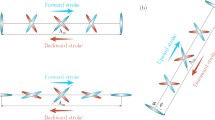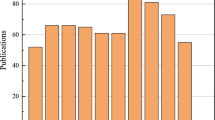Abstract
We briefly summarized how to design and fabricate an insect-mimicking flapping-wing system and demonstrate how to implement inherent pitching stability for stable vertical takeoff. The effect of relative locations of the Center of Gravity (CG) and the mean Aerodynamic Center (AC) on vertical flight was theoretically examined through static force balance consideration. We conducted a series of vertical takeoff tests in which the location of the mean AC was determined using an unsteady Blade Element Theory (BET) previously developed by the authors. Sequential images were captured during the takeoff tests using a high-speed camera. The results demonstrated that inherent pitching stability for vertical takeoff can be achieved by controlling the relative position between the CG and the mean AC of the flapping system.
Similar content being viewed by others
References
Park J H, Yoon K J. Designing a biomimetic ornithopter capable of sustained and controlled flight. Journal of Bionic Engineering, 2008, 5, 39–47.
Thompson P, Ward G, Kelman B, Null W. Design report: Development of surveillance, endurance, and ornithoptic micro air vehicles. The 8th International Micro Air Vehicle Competition Conference, Tucson, Arizona, USA, 2004.
Olson D H, Silin D, Aki M, Murrieta C, Tyler J, Kochevar A, Jehle A, Shkarayev S. Wind tunnel testing and design of fixed and flapping wing micro air vehicles at the university of Arizona. International Micro Air Vehicle Competition, Seoul, South Korea, 2005.
Ifju P G, Jenkins D A, Ettinger S, Lian Y, Shyy W, Wazak M R. Flexible-wing-based micro air vehicles. The 40th AIAA Aerospace Sciences Meeting & Exhibit, Reno, NV, USA, 2002, AIAA 2002-0705.
Krashanitsa R, Silin D, Shkarayev S, Abate G. Flight dynamics of a flapping-wing air vehicle. International Journal of Micro Air Vehicles, 2009, 1, 35–49.
de Croon G, de Clerq K, Ruijsink R, Remes B, and de Wagter R. Design, aerodynamics, and vision-based control of the DelFly. International Journal of Micro Air Vehicles, 2009, 1, 71–97.
Khan Z, Steelman K, Agrawal S. Development of insect thorax based flapping mechanism. IEEE International Conference on Robotics and Automation, Kobe, Japan, 2009, 3651–3656.
Perez-Arancibia N O, Ma K Y, Galloway K C, Greenberg J D, Wood R J. First controlled vertical flight of a biologically inspired microrobot. Bioinspiration and Biomimetics, 2011, 6, 036009.
Nguyen Q V, Park H C, Goo N S, Byun D Y. Characteristics of a beetle’s free flight and a flapping wing system that mimics beetle flight. Journal of Bionic Engineering, 2010, 7, 77–86.
Nguyen Q V, Truong Q T, Park H C, Goo N S, Byun D Y. Measurement of force produced by an insect-mimicking flapping-wing system. Journal of Bionic Engineering, 2010, 7(supp 1), S94–S102.
Azuma A. The Biokinetics of Flying and Swimming, Springer-Verlag, Tokyo, 1992.
Alexander D E. Nature’s Flyers: Birds, Insects, and the Biomechanics of Flight, The Johns Hopkins University Press, Maryland, USA, 2002.
Dudley R. The Biomechanics of Insect Flight: Form, Function, Evolution, Princeton University Press, NJ, USA, 1999.
Weis-Fogh T. Unusual mechanisms for the generation of lift in flying animals. Scientific America, 1975, 233 80–87.
Ellington C P. The aerodynamics of hovering insect flight II. Morphological parameters. Philosophical Transactions of Royal Society B, 1984, 305, 17–40.
Ellington C P. The novel aerodynamics of insect flight: Applications to micro air vehicles. Journal of Experimental Biology, 1999, 202, 3439–3448.
Dickinson M H, Gotz K G. Unsteady aerodynamic performance of model wings at low Reynolds number. Journal of Experimental Biology, 1993, 174, 45–64.
Dickinson M H, Lehmann F O, Sane S P. Wing rotation and the aerodynamics basis of insect flight. Science, 1999, 284, 1954–1960.
Sun M, Tang J. Unsteady aerodynamic force generation by a model fruit fly wing in flapping motion. Journal of Experimental Biology, 2002, 205, 55–70.
Sane S P. Review: The aerodynamics of insect flight. Journal of Experimental Biology, 2003, 206, 4191–4208.
Wang Z J, Birch J M, Dickinson M H. Unsteady forces and flows in low Reynolds number hovering flight: Two-dimensional computations vs. robotic wing experiments. Journal of Experimental Biology, 2004, 207, 449–460.
Wu J H, Sun M. Unsteady aerodynamic forces of a flapping wing. Journal of Experimental Biology, 2004, 207, 1137–1150.
Ansari S A, Zbikowski R, Knowles K. Aerodynamic modeling of insect-like flapping flight for micro air vehicles. Progress in Aerospace Science, 2006, 42, 129–172.
Shyy W, Berg M, Ljungqvist D. Flapping and flexible wings for biological and micro air vehicles. Progress in Aerospace Science, 1999, 35, 455–505.
Sun M, Xiong Y. Dynamic flight stability of a hovering bumblebee. Journal of Experimental Biology, 2005, 208, 447–459.
Taylor G K, Thomas A L R. Animal flight dynamics II. Longitudinal stability in flapping flight. Journal of Theoretical Biology, 2002, 214, 351–370.
Takahashi H, Aoyama Y, Ohsawa K, Tanaka H, Iwase E, Matsumoto K, Shimoyama I. Differential pressure measurement using a free-flying insect-like ornithopter with an MEMS sensor. Bioinspiration and Biomimetics, 2010, 5, 036005.
Sane S P, Dickinson M H. The aerodynamic effects of wing rotation and a revised quasi-steady model of flapping flight. Journal of Experimental Biology, 2002, 205, 1087–1096.
Truong Q T, Nguyen Q V, Truong V T, Park H C, Byun D Y, Goo N S. A modified blade element theory for estimation of forces generated by a beetle-mimicking flapping wing system. Bioinspiration and Biomimetics, 2011, 6 036008.
AeroVironment. DARPA Nano Hummingbird UAV Flying,[2012-8-27], http://youtube.com/watch?v=a8ZbtZqH6Io
Insect-Mimicking Flapping-Wing System: Stable Takeoff,[2012-8-27], http://youtube.com/watch?v=fqR6chf2Xqs
Flapping-Wing System: Forward Flight, [2012-8-27], http://youtube.com/watch?v=owiA6HltGMg
Author information
Authors and Affiliations
Corresponding author
Rights and permissions
About this article
Cite this article
Phan, H.V., Nguyen, Q.V., Truong, Q.T. et al. Stable vertical takeoff of an insect-mimicking flapping-wing system without guide implementing inherent pitching stability. J Bionic Eng 9, 391–401 (2012). https://doi.org/10.1016/S1672-6529(11)60134-0
Published:
Issue Date:
DOI: https://doi.org/10.1016/S1672-6529(11)60134-0




